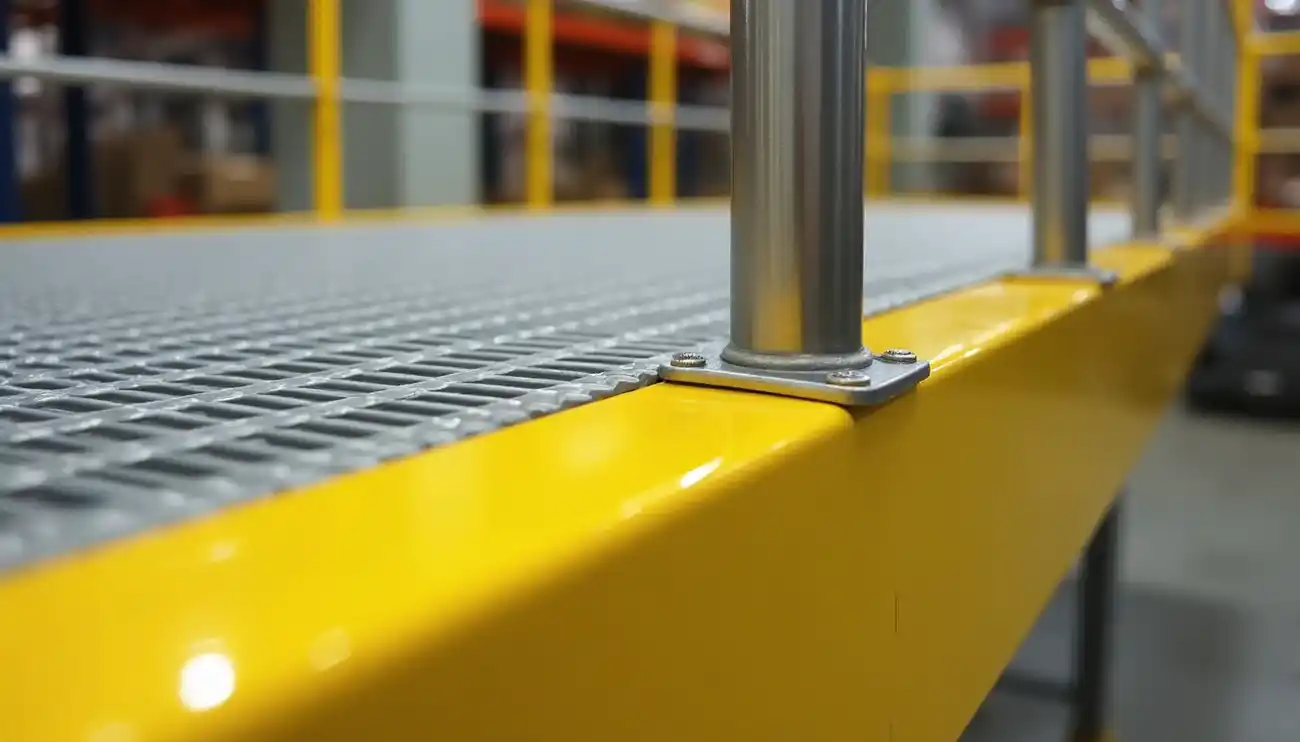Toeboards are usually 3.5 inches high and used on landings and balconies to prevent objects from falling and causing injuries to people below. According to OSHA standard 1910.29(k), these safety features must have a minimum vertical height of 3.5 inches as measured from the top edge to the walking-working surface. This might seem like a minor detail, but it’s actually a critical component of workplace safety.
When designing elevated spaces like balconies, guardrail dimensions and balcony railing height requirements are equally important considerations. Specifically, OSHA requires guardrails on any walking-working surface that is 4 feet or more above a lower level. Additionally, these guardrail systems need to withstand a force of at least 200 pounds at any point along the top rail, while toeboards must be able to withstand 50 pounds being applied to them. In this article, we’ll explain everything you need to know about toeboards, their standard heights, and how to ensure your landings and balconies remain compliant with safety regulations.
What is a toeboard and why is it important?

First of all, safety in elevated work environments depends on multiple protective measures working together. Let’s explore what makes toeboards essential components of workplace safety systems.
Definition and purpose
A toeboard is a vertical protective barrier installed along the edges of elevated platforms, scaffolds, and balconies. These safety features primarily serve as a barrier to prevent tools, materials, and equipment from falling to lower levels where they could harm workers or damage property. Toeboards are usually 3.5 inches high and used on landings and balconies as mandated by OSHA Standard 1917.112(d). Moreover, they function as a visual indicator alerting workers to the edge of an elevated surface, helping prevent accidental steps over the edge.
How toeboards prevent injuries
Falls remain the leading cause of fatalities in construction. However, toeboards address two critical safety hazards. Furthermore, they provide protection against:
- Tools and materials rolling or sliding off elevated surfaces
- Workers accidentally stepping or slipping over edges
- Small items becoming dangerous projectiles when falling from heights
In workplaces where objects could potentially fall on workers below, OSHA requires toeboards to be at least 3.5 inches in height from top edge to floor level and capable of withstanding a force of 50 pounds applied in any direction. If materials near the edge are stacked higher than the toeboard, additional measures like paneling or screening must extend higher to prevent items from falling.
Difference between toeboards and guardrails
In contrast to toeboards, guardrails primarily prevent workers from falling off elevated surfaces. Guardrails are significantly taller—typically 42 inches high—and must withstand much greater forces. Nevertheless, toeboards and guardrails often function as complementary parts of a complete fall protection system.
Prior to 2016, OSHA required all guardrails to include toeboards, yet current regulations only mandate toeboards in specific situations where falling object hazards exist. For instance, they’re required on mobile ladder stands over 10 feet high, around floor holes (except at entrances), and wherever employees below could be exposed to falling objects.
How high are toeboards supposed to be?

The exact height of toeboards varies based on specific regulations and applications. Understanding these measurements is crucial for maintaining safety and regulatory compliance in workplaces with elevated surfaces.
Standard OSHA height: 3.5 inches
The current standard height for toeboards under OSHA regulations is 3.5 inches (8.9 cm) as measured vertically from the top edge to the walking-working surface. This measurement has evolved over time, since OSHA previously required toeboards to be 4 inches high. The change occurred after a proposed rulemaking released on April 10, 1990, which adjusted the requirement downward by half an inch.
Toeboards are usually 3.5 inches high and used on landings and balconies across various industries. Beyond the height requirement, OSHA also mandates that toeboards must be capable of withstanding a force of 50 pounds (222 N) applied in any direction. Additionally, there should be no more than 1/4 inch (0.6 cm) clearance between the bottom of the toeboard and the walking surface.
Exceptions and special cases
Despite the standard 3.5-inch requirement, several exceptions exist. In California, regulations still specify that a standard toeboard shall be 4 inches (nominal) minimum in vertical height. For vehicle repair or assembly pits, the minimum height requirement is reduced to 2.5 inches (6 cm).
Notably, balconies often have stricter requirements. Some building codes mandate that balconies must have an unperforated curb or toe guard at least 12 inches (304.8 mm) high above the floor level at the fascia. This significant increase in height provides enhanced protection for areas where the risk of falling objects might be greater.
Relation to balcony railing height
Toeboards function as complementary components to the overall guardrail system on balconies and elevated surfaces. Whereas the top railing of a guardrail system focuses on preventing people from falling, toeboards prevent objects from sliding off the edge.
The relationship between toeboards and balcony railings creates a comprehensive safety system. Typically, if materials are stacked higher than the toeboard height of 3.5 inches, additional protective measures must be implemented. These might include installing paneling or screening that extends from the toeboard to the midrail or even the top rail of the guardrail system.
Where are toeboards commonly used?

Toeboards find applications across numerous industries and workplace settings, serving as vital safety features in various elevated environments. Although the standard 3.5-inch height remains consistent, their implementation varies based on the specific application and associated risks.
Landings and balconies
Toeboards are essential safety features on landings and balconies where people frequently transition between activities. In these areas, workers might temporarily place tools or materials on the floor, creating falling hazards without proper protection. Indeed, landings and balconies often serve as rest areas or transition points between work tasks. The addition of toeboards helps organizations comply with safety regulations while creating safer working environments. Primarily, these installations prevent tools and equipment from falling off edges and potentially injuring people below.
Scaffolds and elevated platforms
On scaffolding, toeboards become mandatory when there’s a danger of tools, materials, or equipment falling and striking employees below. According to OSHA’s construction scaffold standard, when scaffolds are more than 10 feet (3.1 m) above lower levels, toeboards must be erected along platform edges for sufficient distance to protect employees below. Generally, scaffold toeboards must be at least 4 inches high on all exposed sides. At access points, toeboards may be omitted only if objects are kept away from the edge or if a barricade is used below instead.
Industrial walkways and mezzanines
Industrial settings feature numerous applications for toeboards, particularly:
- Manufacturing facilities with elevated machinery platforms
- Warehouses with raised loading areas and storage platforms
- Maintenance areas where personnel access elevated equipment
For mezzanines specifically, toeboards are typically 4 inches high and work alongside the required 42-3/8″ high handrail and 21″ high mid-rail. OSHA mandates that mezzanine toeboards must run the length of any open space where objects might fall to lower levels. Consequently, these protective barriers are critical in preventing components, tools, or materials from falling onto production floors or personnel working below.
How to stay compliant with OSHA toeboard rules
Maintaining OSHA compliance for toeboards requires attention to several specific regulations and standards. These safety features play a crucial role in preventing objects from falling onto workers below, making proper implementation essential.
Key OSHA standards to follow
First and foremost, OSHA standard 1917.112(d) mandates that toeboards must be at least 3.5 inches (8.9 cm) in height from top edge to floor level. These barriers must be capable of withstanding a force of 50 pounds (222 N) applied in any direction. Furthermore, toeboards must be solid or have openings not exceeding 1 inch (2.5 cm) in greatest dimension.
For construction sites specifically, OSHA regulation 1926.502(j) requires toeboards when there’s a risk of objects falling from overhead work areas. Essentially, the clearance between the toeboard and the walking surface should not exceed 1/4 inch (0.6 cm).
How to measure and test your toeboards
To properly measure toeboards, check the vertical height from the top edge to the walking-working surface – this should be at least 3.5 inches. Afterwards, verify the gap between the bottom of the toeboard and the walking surface doesn’t exceed 1/4 inch.
Testing involves applying a 50-pound force in both downward and outward directions at various points along the toeboard. Above all, ensure there are no gaps that could allow objects to fall through.
When to update or replace existing systems
Under those circumstances where materials are stacked higher than the toeboard’s top edge, you’ll need to install additional paneling or screening from the walking surface to the guardrail’s top rail or midrail. Regular inspections should check for:
- Secure attachment to the platform
- Proper height maintenance
- No excessive gaps or openings
- Ability to withstand required forces
Before 2016, OSHA required toeboards with every guardrail, but current regulations only mandate them in specific situations. Nevertheless, including them proactively is advisable, as it’s better to have them installed before they’re needed.
Conclusion
Toeboards remain essential safety components across various elevated work environments. Though seemingly simple, these 3.5-inch barriers significantly reduce workplace hazards by preventing tools and materials from falling onto workers below. Additionally, they serve as visual indicators of dangerous edges, helping prevent accidental steps over elevated surfaces.
OSHA standards clearly specify that toeboards must reach a minimum height of 3.5 inches and withstand forces of 50 pounds applied in any direction. Nevertheless, certain applications might require taller barriers, particularly where materials stack higher than standard toeboard height or where specialized industry regulations apply.
Proper implementation of toeboards alongside guardrails creates comprehensive safety systems that protect both workers on elevated surfaces and those working below. During regular safety inspections, measuring toeboard height, checking clearances, and testing load capacity ensures ongoing compliance and effectiveness.
Ultimately, understanding toeboard requirements helps facility managers, safety officers, and construction supervisors maintain safer workplaces while meeting regulatory obligations. Consequently, this small but critical safety feature deserves careful attention when designing, building, or maintaining any elevated work surface, landing, or balcony.
FAQs
Q1. What is the standard height for toeboards on landings and balconies? The standard height for toeboards on landings and balconies is 3.5 inches (8.9 cm), as measured from the top edge to the walking-working surface.
Q2. Why are toeboards important in workplace safety? Toeboards are crucial for preventing tools, materials, and equipment from falling off elevated surfaces, protecting workers below from potential injuries. They also serve as visual indicators of edges, helping to prevent accidental steps over elevated surfaces.
Q3. What is the difference between toeboards and guardrails? While toeboards are typically 3.5 inches high and prevent objects from falling, guardrails are much taller (usually 42 inches) and primarily prevent workers from falling off elevated surfaces. Both work together as part of a comprehensive fall protection system.
Q4. Where are toeboards commonly used besides landings and balconies? Toeboards are commonly used on scaffolds, elevated platforms, industrial walkways, mezzanines, and in manufacturing facilities with elevated machinery platforms. They’re essential in any workplace where there’s a risk of objects falling onto workers below.
Q5. How can employers ensure compliance with OSHA toeboard regulations? To comply with OSHA regulations, employers should ensure toeboards are at least 3.5 inches high, can withstand a force of 50 pounds in any direction, and have no more than 1/4 inch clearance from the walking surface. Regular inspections and testing are crucial for maintaining compliance.












